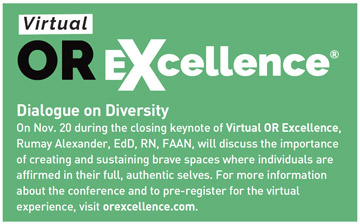Surgery must be a welcoming space for staff members and patients of all races, sexualities, genders, gender identities, ages, nationalities and physical abilities. Widespread improvements are needed to increase diversity across health care, but it's difficult to address this subject without alienating individuals who have different backgrounds, beliefs, life experiences and viewpoints. Conversations about equality and inclusion can be uncomfortable, but are essential for true progress to occur and become easier with the right ground rules in place.
- Home
- The Magazine
- Article
Diversity & Inclusion: Let's Learn How to Discuss Our Differences
By: Rumay Alexander
Published: 8/10/2020
Constructive communication will keep needed conversations going.
1. Create a safe space
Trust and openness are the foundational elements of constructive dialogue. Staff members take risks when sharing their honest opinions on what's often an emotional topic, and worry about saying the wrong things while searching for the right words. Don't expect everyone to master their feelings and know how to clearly express their thoughts. Make sure staff members give each other the benefit of the doubt and understand that comments or beliefs will not be judged. Emotions can hijack the brain of even the most well-intentioned person and their controversial statements might be based on feelings instead of facts. If you question what someone says, ask them for specifics of what they mean in a non-confrontational tone.
Keep in mind that anonymity might be important to some staff members who fear retaliation for the comments they make. Eventually you'll get to a place where they won't worry about being identified, but don't expect to begin there.
2. Start forums
Thought exercises involving staff members who work in specific departments or clinical spaces can spark bigger movements across larger organizations or facilities. The practice helps them self-discover and get to know each other on a deeper level, which provides insights on past perspectives and experiences that shape current beliefs and actions.
Keep in mind that power differential is a real phenomenon and impedes open and honest discussions. It's a good idea to have staff members talk amongst themselves before meeting with facility leaders. Put them in smaller discussion groups and designate someone to record what was said and share the dialogue with the entire staff. There's a way to present the discussion's main points with decency. At the same time, the truth is important. Don't sugarcoat or doctor language and use direct quotes from staff members (even if the source doesn't want to be identified) to demonstrate the authenticity of the feedback.
People love to talk about what goes on with others, not themselves. That's why I often pick a relevant external event or storyline — from the past or the headlines — for staff to learn about and discuss. Ask for their thoughts on how those involved handled the situation. Then ask if they think a related issue is a problem at your facility. Using an outside example that fits what's going on internally often gets the conversation started and the ideas flowing.
Also consider partnering with a diversity consultant. Staff members might be more willing to share their true feelings with an impartial professional from outside your organization.
3. Commit to the process
Overcoming the inherent barriers to treating all people with fairness and equality demands hard work. Hoping for change is not a concrete strategy. You must fully support discussions about diversity and inclusion, and commit to receiving education and training on these important issues. Creating a more diverse workplace should become an agenda item. Treating it like other strategic priorities will help you achieve the results you need. If a more diverse workplace is a priority to you, give it time, money and people. Any important initiative needs those three things to thrive.
Far-reaching impact

Prejudice and bigotry are somehow worse when they occur in healthcare facilities, where patients expect to be respected and staff want to work in supportive and fair cultures. I often refer to a quote by American writer Frederick Buechner: "Humanity is like a spider web. If you touch it anywhere, you set the whole thing trembling. As we go through this world and act with kindness, indifference or hostility toward the people we meet, we set the great spider web atremble." The lives you touch will touch other lives, who will in turn touch others. You don't know where the trembling stops or in what time or place your touch will be felt. Discussions about diversity and inclusion involve what it means to be part of humanity. The choices we make today could impact future generations. Let's continue to discuss ways to make the best decisions moving forward. OSM
.svg?sfvrsn=be606e78_3)
.svg?sfvrsn=56b2f850_5)